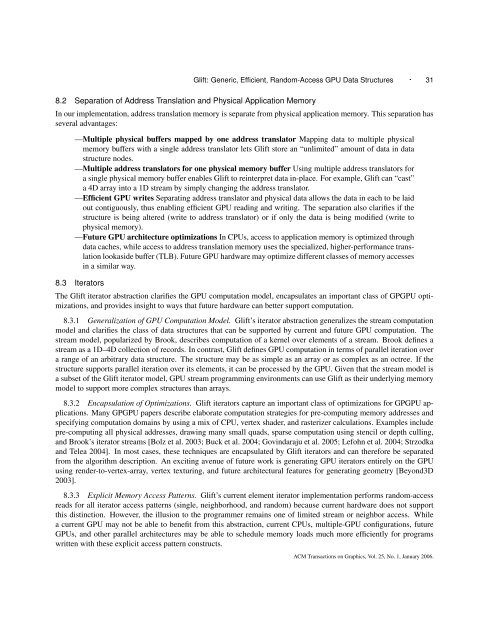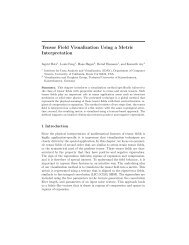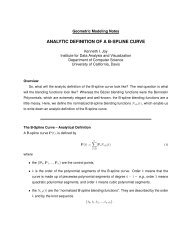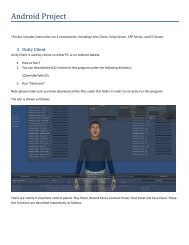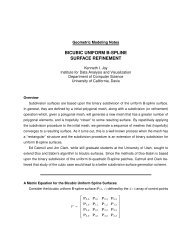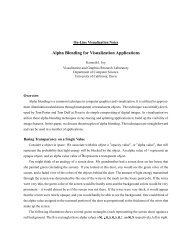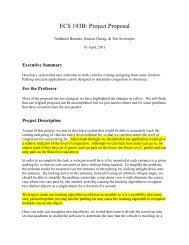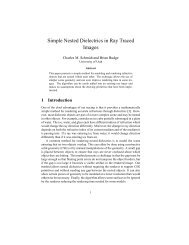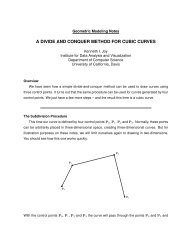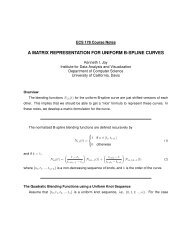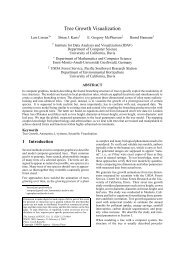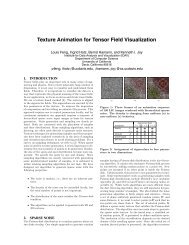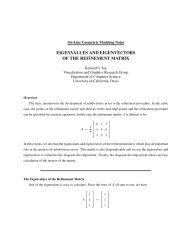Paper - IDAV: Institute for Data Analysis and Visualization
Paper - IDAV: Institute for Data Analysis and Visualization
Paper - IDAV: Institute for Data Analysis and Visualization
Create successful ePaper yourself
Turn your PDF publications into a flip-book with our unique Google optimized e-Paper software.
Glift: Generic, Efficient, R<strong>and</strong>om-Access GPU <strong>Data</strong> Structures · 318.2 Separation of Address Translation <strong>and</strong> Physical Application MemoryIn our implementation, address translation memory is separate from physical application memory. This separation hasseveral advantages:—Multiple physical buffers mapped by one address translator Mapping data to multiple physicalmemory buffers with a single address translator lets Glift store an “unlimited” amount of data in datastructure nodes.—Multiple address translators <strong>for</strong> one physical memory buffer Using multiple address translators <strong>for</strong>a single physical memory buffer enables Glift to reinterpret data in-place. For example, Glift can “cast”a 4D array into a 1D stream by simply changing the address translator.—Efficient GPU writes Separating address translator <strong>and</strong> physical data allows the data in each to be laidout contiguously, thus enabling efficient GPU reading <strong>and</strong> writing. The separation also clarifies if thestructure is being altered (write to address translator) or if only the data is being modified (write tophysical memory).—Future GPU architecture optimizations In CPUs, access to application memory is optimized throughdata caches, while access to address translation memory uses the specialized, higher-per<strong>for</strong>mance translationlookaside buffer (TLB). Future GPU hardware may optimize different classes of memory accessesin a similar way.8.3 IteratorsThe Glift iterator abstraction clarifies the GPU computation model, encapsulates an important class of GPGPU optimizations,<strong>and</strong> provides insight to ways that future hardware can better support computation.8.3.1 Generalization of GPU Computation Model. Glift’s iterator abstraction generalizes the stream computationmodel <strong>and</strong> clarifies the class of data structures that can be supported by current <strong>and</strong> future GPU computation. Thestream model, popularized by Brook, describes computation of a kernel over elements of a stream. Brook defines astream as a 1D–4D collection of records. In contrast, Glift defines GPU computation in terms of parallel iteration overa range of an arbitrary data structure. The structure may be as simple as an array or as complex as an octree. If thestructure supports parallel iteration over its elements, it can be processed by the GPU. Given that the stream model isa subset of the Glift iterator model, GPU stream programming environments can use Glift as their underlying memorymodel to support more complex structures than arrays.8.3.2 Encapsulation of Optimizations. Glift iterators capture an important class of optimizations <strong>for</strong> GPGPU applications.Many GPGPU papers describe elaborate computation strategies <strong>for</strong> pre-computing memory addresses <strong>and</strong>specifying computation domains by using a mix of CPU, vertex shader, <strong>and</strong> rasterizer calculations. Examples includepre-computing all physical addresses, drawing many small quads, sparse computation using stencil or depth culling,<strong>and</strong> Brook’s iterator streams [Bolz et al. 2003; Buck et al. 2004; Govindaraju et al. 2005; Lefohn et al. 2004; Strzodka<strong>and</strong> Telea 2004]. In most cases, these techniques are encapsulated by Glift iterators <strong>and</strong> can there<strong>for</strong>e be separatedfrom the algorithm description. An exciting avenue of future work is generating GPU iterators entirely on the GPUusing render-to-vertex-array, vertex texturing, <strong>and</strong> future architectural features <strong>for</strong> generating geometry [Beyond3D2003].8.3.3 Explicit Memory Access Patterns. Glift’s current element iterator implementation per<strong>for</strong>ms r<strong>and</strong>om-accessreads <strong>for</strong> all iterator access patterns (single, neighborhood, <strong>and</strong> r<strong>and</strong>om) because current hardware does not supportthis distinction. However, the illusion to the programmer remains one of limited stream or neighbor access. Whilea current GPU may not be able to benefit from this abstraction, current CPUs, multiple-GPU configurations, futureGPUs, <strong>and</strong> other parallel architectures may be able to schedule memory loads much more efficiently <strong>for</strong> programswritten with these explicit access pattern constructs.ACM Transactions on Graphics, Vol. 25, No. 1, January 2006.


